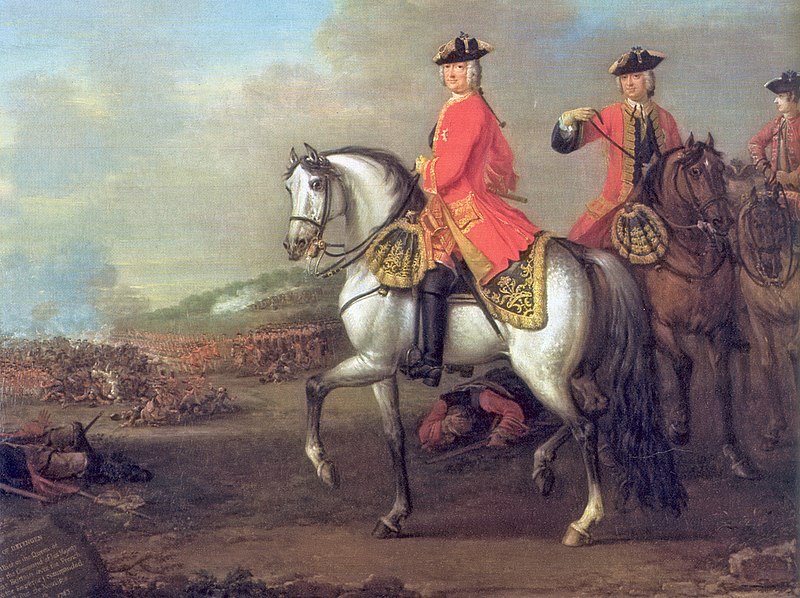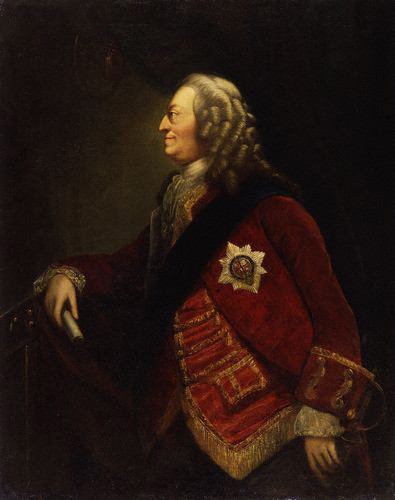by Susan Flantzer © Unofficial Royalty 2015

Credit – Wikipedia
The last British monarch born outside of Great Britain, King George II was born at Schloss Herrenhausen in Hanover, Duchy of Brunswick and Lüneburg, now in the German state of Lower Saxony, on November 10, 1683. He was the elder of the two children of Georg Ludwig, Hereditary Prince of Brunswick-Lüneburg (later King George I of Great Britain), and his wife and first cousin, Sophia Dorothea of Celle. Georg Ludwig had a change in fortune when the British House of Stuart failed to produce a legitimate Protestant heir. His mother Sophia of Hanover was the closest Protestant heir and was named the heiress presumptive to the British throne. However, Sophia of Hanover died two months before Queen Anne of Great Britain died and Georg Ludwig succeeded to the British throne as King George I in 1714 upon the death of Queen Anne.
George had one sister:
- Sophia Dorothea of Hanover (1687 – 1757), married 1706 Friedrich Wilhelm, Margrave of Brandenburg (later King Friedrich I of Prussia), had issue including King Friedrich II of Prussia (Frederick the Great)

George with his mother and sister, circa 1691; Credit – Wikipedia
George’s parents both committed adultery and their marriage was dissolved in 1694 when George was 11 years old. His mother was considered the guilty party and was confined in the Castle of Ahlden in Celle, Principality of Celle, now in Lower Saxony, Germany, for the rest of her life and George never saw her again. George and his sister Sophia were raised by their grandmother, the Dowager Electress of Hanover Sophia with the help of her Mistress of the Robes, Frau von Harling. The Dowager Electress provided English tutors for her grandchildren and great-grandchildren as soon as she was declared heiress presumptive to the British throne by the 1701 Act of Settlement. George also studied German, Italian, and particularly enjoyed studying genealogy, military history, and battle tactics. In 1705, George was naturalized as a British citizen via the Sophia Naturalization Act and was created a Knight of the Garter in 1706. On November 9, 1706, he was created Baron Tewkesbury, Viscount Northallerton, Earl of Milford Haven, and Duke and Marquess of Cambridge.
George’s father was keen on his marrying a woman he loved, so George traveled incognito to inspect a potential bride, Caroline of Ansbach, the daughter of Johann Friedrich, Margrave of Brandenburg-Ansbach and his wife Princess Eleonore of Saxony-Eisenach. George immediately liked Caroline and the couple married on August 22, 1705, at the palace chapel at Schloss Herrenhausen. The marriage was a successful, happy one although George had mistresses which Caroline knew about. The couple had eight children and through their children’s marriages, George and Caroline are the ancestors of many European royal families including the British, Danish, Dutch, Greek, Norwegian, Romanian, Russian, Spanish, and Swedish Royal Families.
- Frederick, Prince of Wales (1707 – 1751), married Princess Augusta of Saxe-Gotha, had issue, including King George III
- Anne, Princess Royal (1709 – 1759), married Willem IV, Prince of Orange, had issue
- Princess Amelia (1711 – 1786), unmarried
- Princess Caroline (1713 – 1757), unmarried
- Prince George William (1717 – 1718), died in infancy
- Prince William, Duke of Cumberland (1721 – 1765), unmarried
- Princess Mary (1723 – 1772), married Friedrich II, Landgrave of Hesse-Kassel, had issue
- Princess Louise (1724 -1751), married Frederik V, King of Denmark and Norway

George II and his family; Credit – Wikipedia
Queen Anne died on August 1, 1714, shortly after the death of the Electress Sophia on June 8, 1714, and Sophia’s son succeeded to the British throne as King George I, the first monarch of the House of Hanover. His eldest son George was automatically Duke of Cornwall, Duke of Rothesay, and Earl of Carrick. On September 27, 1714, King George I created his eldest son Prince of Wales and Earl of Chester.

George as Prince of Wales; Credit – Wikipedia
George had a very poor relationship with his father. The first big rift occurred because of a disagreement over the choice of godparents for the Prince and Princess of Wales’ short-lived son George William, born in 1717. The disagreement grew out of proportion, and George was placed under arrest. The result was that George and Caroline were exiled from St. James’ Palace. They moved into Leicester House in Leicester Square, London which became their chief residence for the rest of King George I’s reign. However, their children were kept at St. James’ Palace in the custody of their grandfather.
On June 11, 1727, King George I died in Hanover, was buried there, and his son succeeded him as King George II. George II was crowned at Westminster Abbey on October 22, 1727. The composer George Frederick Handel was commissioned to write four new anthems for the coronation, including the rousing Zadok the Priest which has been played at every British coronation ever since. You can see it performed at the link below.

King George II, studio of Charles Jervas, oil on canvas, circa 1727 NPG 368 © National Portrait Gallery, London
Like his father, George had a negative relationship with his eldest son Frederick, Prince of Wales. Upon his father’s accession, George and his wife Caroline went to live in Great Britain as Prince and Princess of Wales. They left seven-year-old Frederick, now second in the line of succession to the British throne, in Hanover in the care of his great-uncle Ernest Augustus, Prince-Bishop of Osnabrück, and they did not see their son again for 14 years. Certainly, this long separation during childhood was a factor in the negative relationship Frederick had with his parents as an adult. In 1728, Frederick, who automatically became Duke of Cornwall and Duke of Rothesay at his father’s accession, was summoned to London. There was more evidence of the feud between Frederick and his parents. He was the heir to the throne but was not even met by any officials when he first arrived in London and had to take a hackney carriage to St. James’ Palace.
When Frederick’s wife Augusta went into labor with her first child at Hampton Court Palace where the King and Queen were in residence, Frederick insisted that Augusta endure a bumpy carriage ride back to St. James’ Palace in London just to prevent his hated parents from being present at the birth. This event created an even larger rift between Frederick and his parents. Frederick predeceased his father, dying in 1751 at the age of 44. King George II was playing cards with his mistress when he was told of Frederick’s death. He continued playing cards and later said, “I have lost my eldest son, but I am glad,” so the feud between father and son did not even end with death. Frederick’s eldest son George was now the heir apparent and was created Prince of Wales.

Frederick, Prince of Wales; Credit – Wikipedia
Queen Caroline played a greater role in governmental affairs than any queen consort since the Middle Ages. She gave her support to Prime Minister Robert Walpole and found a great mentor in John Hervey, 2nd Baron Hervey, a Whig Member of Parliament. Caroline’s influence is illustrated in a couplet popular at the time:
You may strut, dapper George, but ’twill all be in vain,
We know ’tis Queen Caroline, not you, that reign.
On November 20, 1737, Queen Caroline died of gangrene following an operation. As she lay dying, she begged her grief-stricken husband to marry again. George replied, “Never, never. I shall have only mistresses.” When George died, he left instructions that the sideboards of their coffins be removed so the two could be joined together in death.

Queen Caroline, circa 1735, by Joseph Highmore; Credit – Wikipedia
In 1743, King George II became the last British monarch to lead an army into battle at the Battle of Dettingen during the War of the Austrian Succession. The Jacobites once again attempted to put a Catholic Stuart on the British throne in 1745-1746 during the Jacobite Rising of 1745. The Stuart in rebellion this time was Charles Edward Stuart, “Bonnie Prince Charlie” or “the Young Pretender.” Charles Edward was the son of the Old Pretender, James Francis Edward Stuart and the grandson of King James II. The rebellion failed and the Jacobites were defeated once and for all at the Battle of Culloden in 1746 by an army led by King George II’s son Prince William, Duke of Cumberland who gained the nickname “Butcher of Culloden.”

King George II at the Battle of Dettingen; Credit – Wikipedia
The British National Anthem has its origins during King George II’s reign. The earliest version, God Save Great George Our King, was first heard in 1745 when King George II attended a gala performance at Drury Lane Theater in London in celebration of the defeat of Charles Edward Stuart, “Bonnie Prince Charlie” or “the Young Pretender.” King George II is related to another famous musical work, Handel’s Hallelujah Chorus. No one really knows why or when the custom of standing during the Hallelujah Chorus began. The most common theory is that King George II, attending the London premiere of “The Messiah’’ in March 1743, was so moved by the Hallelujah Chorus that he stood up. If the king stands, everybody stands. However, there is no contemporary evidence he was at the concert.

King George II, circa 1753 by Thomas Worlidge; Credit – Wikipedia
On October 25, 1760, King George II woke up early at Kensington Palace and had his usual cup of chocolate. He asked about the direction of the wind as he was anxious about receiving his overseas mail, and then he entered his water closet. A few minutes later, his valet heard a crash and found George lying on the floor. He was put into bed and asked for his favorite daughter Princess Amelia, but he died before the princess reached him. An autopsy showed that he died of a ruptured aortic aneurysm. King George II was buried in Westminster Abbey, the last monarch to be buried there. He was succeeded by his grandson, King George III.

Inscription on the floor of the Henry VII Chapel at Westminster Abbey marking the grave of George II, Credit: www.findagrave.com
This article is the intellectual property of Unofficial Royalty and is NOT TO BE COPIED, EDITED, OR POSTED IN ANY FORM ON ANOTHER WEBSITE under any circumstances. It is permissible to use a link that directs to Unofficial Royalty.
House of Hanover Resources at Unofficial Royalty
